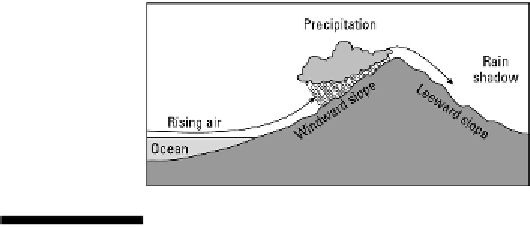Geography Reference
In-Depth Information
The numerical relationship between temperature change and elevation change is called the
lapse rate.
It works out to about 3.5° F per 1,000 feet, or 6.4° C per 1,000 meters. That is, if
youhavetwohikersonamountainseparated by1,000feetofvertical distance, thentheperson
higher up is experiencing a temperature that is about 3.5° F colder than the person down slope.
Parenthetically, I say “about” because
humidity
— the amount of vapor in the air — can and
does tamper with these formulae. Therefore, think of the above numbers as average figures.
Windward slope, leeward slope
In addition to temperature, altitude can have a profound effect on patterns of precipitation. An
air current is forced to rise when it meets a mountain (see Figure 9-5). As it does so, its vapor
cools and condenses, forming raindrops (or snowflakes). Precipitation that is produced in this
manner is called
orographic
(from the Greek
oros,
mountain), meaning that it is mountain-re-
lated. The heaviest rains and snows tend to occur on the
windward
slope, which is the side of
the mountain from which the wind is blowing.
Figure 9-5:
Given a domin-
ant wind direc-
tion, mountains
and mountain
ranges may ex-
hibit a wet wind-
ward slope and
dry
leeward
slope.
After cresting the summit, the air descends. As it does so, it warms, which is the opposite of what
air needs to do in order to condense and form rain. But the air also has little vapor remaining, so the
prospects for precipitation are just about zilch. The result is a dry
leeward
slope, whose droughty en-
virons are said to be in a
rainshadow.




